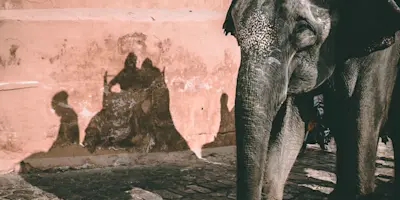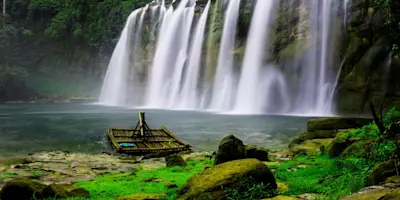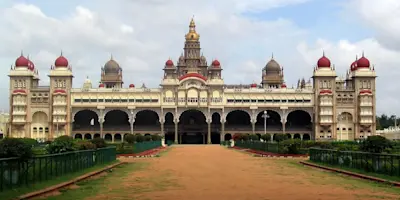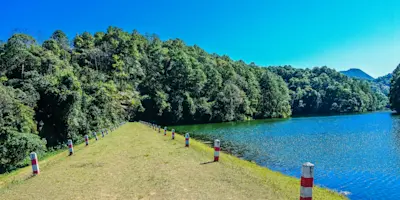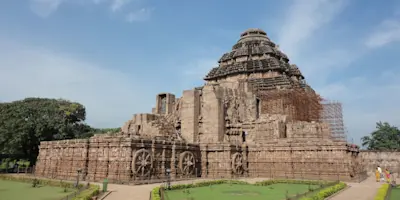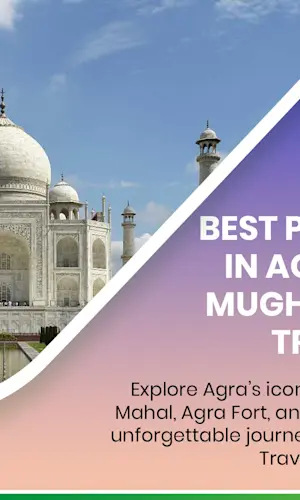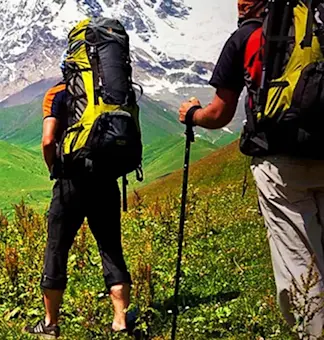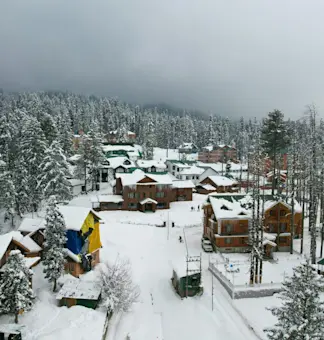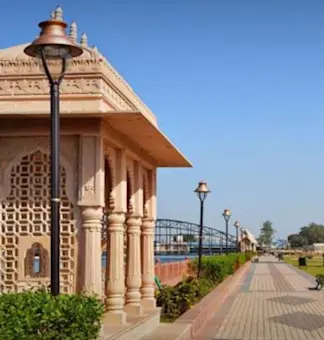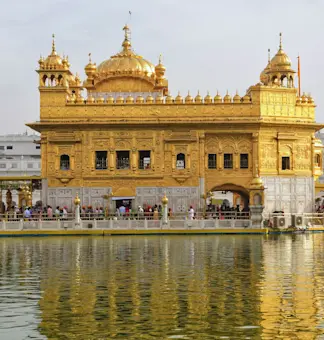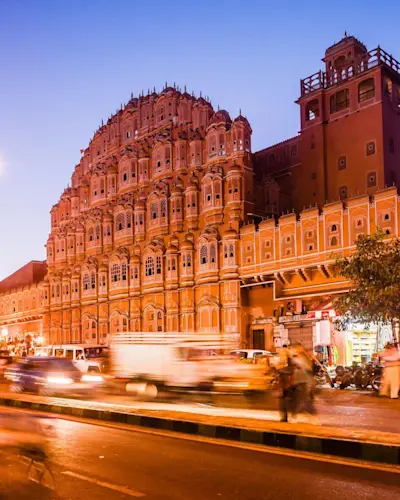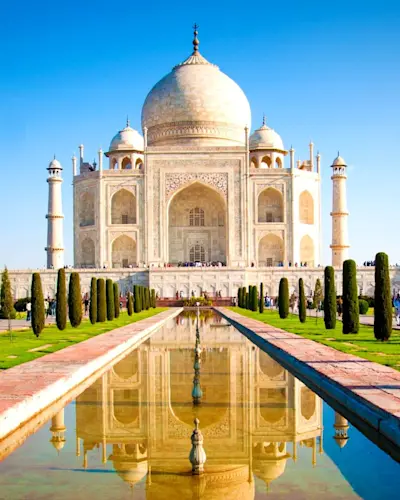🕌 Best Places to Visit in Agra | Explore Mughal Heritage – Travel Taxi
Discover Agra's magnificent Mughal heritage through this comprehensive guide to the city's most significant monuments. From the incomparable Taj Mahal to the imposing Agra Fort and the abandoned city of Fatehpur Sikri, Agra offers extraordinary architectural wonders reflecting the grandeur of India's Mughal era and its enduring cultural legacy.
Discovering Agra: The Crown Jewel of Mughal Architecture
Agra, located in the northern Indian state of Uttar Pradesh, stands as a monumental testament to the architectural splendor of the Mughal Empire. Once the imperial capital, this historic city along the banks of the Yamuna River houses some of the world's most extraordinary architectural achievements, including the incomparable Taj Mahal. While many visitors arrive with visions of this marble masterpiece alone, Agra rewards travelers with a remarkable collection of historical sites that collectively tell the story of one of history's most sophisticated artistic and architectural traditions.This comprehensive guide explores the essential places to be visited in Agra, from iconic UNESCO World Heritage sites to lesser-known gems, providing insights into their historical significance, architectural features, and practical visitor information. Whether planning a day trip from Delhi or a more extended exploration, this guide will help you navigate Agra's magnificent Mughal heritage with confidence and appreciation.
UNESCO World Heritage Sites: Agra's Crown Jewels
Taj Mahal: The Ultimate Monument to Love
The Taj Mahal stands as not merely Agra's most famous monument but quite possibly the world's most recognized building. This immaculate white marble mausoleum was built between 1631 and 1648 by Emperor Shah Jahan to honor his beloved wife Mumtaz Mahal, who died during childbirth.Visitor Information:
Location:
Southern bank of Yamuna River, eastern Agra
Opening Hours:
Sunrise to sunset, closed Fridays
Entry Fee:
₹1,100 for foreigners, ₹50 for Indians, additional fees for main mausoleum
Best Time to Visit:
Sunrise for magical light and fewer crowds; winter months for clear skies
Highlights:
Perfect symmetrical design, intricate marble inlay work, changing colors throughout day, Mughal gardens, panoramic river views
The Taj Mahal represents the pinnacle of Mughal architecture, combining elements from Persian, Islamic, and Indian architectural styles. Its perfect symmetry, sublime proportions, and the way light plays across its marble surfaces throughout the day create an almost otherworldly experience. Beyond the iconic central dome and minarets, visitors should appreciate the intricate pietra dura (stone inlay work), calligraphy, and the surrounding formal gardens designed in the classic char bagh (four-quadrant) style.As one of the world's most visited monuments, timing your visit is crucial. Early morning arrivals, just as gates open, offer both magical lighting conditions and relatively smaller crowds. A full appreciation requires at least 2-3 hours, allowing time to explore not only the main mausoleum but also the ancillary buildings, gardens, and the often-overlooked Taj Museum.
Agra Fort: Fortress, Palace, and Prison
This imposing red sandstone fortress, begun by Emperor Akbar in 1565 and further developed by his successors, served as the main residence of the Mughal Emperors until 1638 when the capital shifted to Delhi. The massive complex combines military might with extraordinary palatial elegance.Visitor Information:
Location:
Northwestern Agra, 2.5 km from Taj Mahal
Opening Hours:
Sunrise to sunset, daily
Entry Fee:
₹650 for foreigners, ₹50 for Indians
Best Time to Visit:
Early morning or late afternoon for comfortable temperatures and good photography light
Highlights:
Jahangir Palace, Khas Mahal, Sheesh Mahal (mirror palace), Diwan-i-Am (Hall of Public Audience), Diwan-i-Khas (Hall of Private Audience), views of Taj Mahal
While often overshadowed by the Taj Mahal, Agra Fort offers an equally impressive experience that provides crucial context for understanding Mughal history and architecture. The 94-acre complex served multiple purposes: military garrison, royal residence, administrative center, and ultimately the gilded prison where Shah Jahan spent his final years, reportedly gazing at his creation, the Taj Mahal, in the distance.Visitors should allocate at least 2-3 hours to properly explore the fort's many sections, which showcase the evolution of Mughal architectural styles from Akbar's solid red sandstone structures to Shah Jahan's delicate white marble pavilions. Particularly noteworthy are the Musamman Burj, an octagonal tower where Shah Jahan was imprisoned, and the Jahangir Palace, which reveals the synthesis of Hindu and Islamic architectural elements characteristic of Akbar's reign.
Fatehpur Sikri: The Abandoned Imperial City
Located approximately 40 km from Agra, this perfectly preserved 16th-century imperial city was built by Emperor Akbar as his capital but abandoned after just 14 years due to water shortages. Today, it stands as a remarkable time capsule of Mughal urban planning and architecture.Visitor Information:
Location:
40 km west of Agra
Opening Hours:
Sunrise to sunset, daily
Entry Fee:
₹610 for foreigners, ₹40 for Indians
Best Time to Visit:
Early morning for fewer crowds and better photography
Highlights:
Buland Darwaza (Victory Gate), Jama Masjid, Tomb of Salim Chishti, Panch Mahal, Diwan-i-Khas with central column, Anup Talao (pool)
Fatehpur Sikri represents Emperor Akbar's ambitious vision and architectural experimentation, incorporating elements of Persian, Islamic, and Hindu design. The complex includes royal palaces, courts, a magnificent mosque, and the tomb of Sufi saint Salim Chishti, whose blessing supposedly enabled Akbar to have a son and heir.The city's remarkable state of preservation allows visitors to imagine life during the height of Mughal power. The innovative architectural elements include the Panch Mahal (a five-story pavilion), the Diwan-i-Khas with its unique central column, and the intricate carvings throughout that reflect Akbar's syncretic religious philosophy. Most visitors explore Fatehpur Sikri as a day trip from Agra, allocating 3-4 hours for exploration plus travel time.
Magnificent Tombs and Mausoleums
Itimad-ud-Daulah's Tomb: The Baby Taj
Often called the "Baby Taj" or "Draft of the Taj Mahal," this exquisite marble tomb was built between 1622 and 1628 by Empress Nur Jahan for her father, Mirza Ghiyas Beg (who held the title Itimad-ud-Daulah). The monument represents a significant transition in Mughal architecture from red sandstone to white marble and extensive use of pietra dura inlay work.Visitor Information:
Location:
Eastern bank of Yamuna River
Opening Hours:
Sunrise to sunset, daily
Entry Fee:
₹310 for foreigners, ₹30 for Indians
Best Time to Visit:
Morning for soft light on the marble
Highlights:
First Mughal structure completely in marble, intricate inlay work, geometric garden design, riverside location
This jewel-box mausoleum predates the Taj Mahal and showcases many design elements later perfected in its more famous successor. The delicate marble screens, precise geometric patterns, and nature-inspired inlay work using semi-precious stones all represent innovations in Mughal architectural decoration. The compact size of Itimad-ud-Daulah's tomb allows visitors to appreciate the intricate details more intimately than is possible at the grander Taj Mahal.The tomb's location on the opposite side of the Yamuna from the main tourist circuit means it receives fewer visitors, offering a more peaceful experience. The surrounding garden, though smaller than the Taj's, follows similar char bagh principles with water channels and symmetrical quadrants.
Akbar's Tomb at Sikandra
Located in Sikandra, a suburb of Agra, this magnificent tomb complex houses the remains of Emperor Akbar the Great. Built between 1605-1613, it was actually commissioned by Akbar himself before his death and completed by his son Jahangir.Visitor Information:
Location:
Sikandra, 10 km northwest of Agra city center
Opening Hours:
Sunrise to sunset, daily
Entry Fee:
₹310 for foreigners, ₹30 for Indians
Best Time to Visit:
Early morning when resident deer are active in the gardens
Highlights:
Unique architectural style blending Hindu, Christian, Islamic, Buddhist, and Jain motifs; impressive gateway, spacious gardens with resident deer
The tomb represents Akbar's syncretic religious vision, incorporating elements from multiple faiths—a physical manifestation of his concept of Din-i Ilahi (Divine Faith) that sought to combine aspects of different religions. Unlike later Mughal tombs, Akbar's mausoleum is primarily constructed of red sandstone with limited marble elements.The complex's most distinctive feature is its unique five-tiered structure that diminishes in size as it rises, capped not by a dome but by a pavilion of white marble. The false tomb (the actual burial chamber is in a plain underground room) sits on the top level. The main gateway features four white marble minarets, anticipating elements that would later appear in the Taj Mahal.
Chini Ka Rauza: Persian Influence in Agra
This lesser-known gem represents one of Agra's most unique architectural achievements. Built between 1635 and 1639, it serves as the tomb of Allama Afzal Khan Mullah, a poet and chief minister of Shah Jahan. Its name, "China Tomb," refers to the distinctive blue glazed tiles (chinaware) that once covered much of its exterior.Visitor Information:
Location:
Eastern bank of Yamuna River, north of Itimad-ud-Daulah's Tomb
Opening Hours:
Sunrise to sunset, daily
Entry Fee:
Free
Best Time to Visit:
Morning for good photography conditions
Highlights:
Distinctive Persian-influenced architecture, remnants of blue tile work, uniquely shaped dome, peaceful setting away from tourist crowds
Though now in a partially ruined state, Chini Ka Rauza remains architecturally significant as the only purely Persian-style building in Agra. The striking structure features an unusual bulbous dome and was once completely decorated with vibrant blue ceramic tiles in intricate geometric and floral patterns. While many tiles have fallen away over centuries, enough remain to suggest the original spectacular appearance.The monument sees relatively few visitors despite being just a short distance from Itimad-ud-Daulah's Tomb, making it ideal for those seeking to escape crowds and experience a different facet of Mughal artistic influence. The peaceful riverside location adds to its contemplative atmosphere.
Religious Sites with Historical Significance
Jama Masjid: Grand Mosque of Agra
This imposing mosque, built in 1648 by Shah Jahan's daughter Jahanara Begum, stands in the heart of the old city. Once the city's principal mosque, its red sandstone and white marble design reflects classic Mughal architectural elements on a grand scale.Visitor Information:
Location:
Kinari Bazaar area, central Agra
Opening Hours:
7:00 AM to 12:00 PM, 1:30 PM to 6:30 PM (closed during prayer times)
Entry Fee:
Free (donations appreciated)
Dress Code:
Conservative attire required; head covering for women
Highlights:
Impressive sandstone and marble construction, massive central courtyard, three large domes, intricate calligraphy
The Jama Masjid's design shows clear influences from the Jama Masjid in Delhi, also built under Shah Jahan, though on a somewhat smaller scale. The mosque features a large central courtyard that can accommodate thousands of worshippers, magnificent arched entrances, and intricate floral patterns carved into red sandstone.Non-Muslim visitors are welcome outside prayer times but should be respectful of religious customs. The mosque's central location also makes it an excellent starting point for exploring Agra's bustling old city markets, where traditions of craft and commerce dating to the Mughal era continue today.
Guru ka Tal: Sikh Heritage in Agra
Originally built as a reservoir in 1610 during Jahangir's reign to collect and store rainwater, this site gained religious significance after the ninth Sikh Guru, Guru Tegh Bahadur, stayed here in 1670. The complex now houses a gurudwara (Sikh temple) and the restored remnants of the original eight pavilions around what was once a large tank.Visitor Information:
Location:
Near Sikandra, northwestern Agra
Opening Hours:
Open throughout the day
Entry Fee:
Free
Visitor Conduct:
Head covering required; remove shoes before entering gurudwara
Highlights:
Octagonal design with sandstone pavilions, peaceful atmosphere, historical Sikh connection
While only three of the original eight pavilions survived into modern times, restoration work has partially reconstructed the others, giving visitors a sense of the original design. The complex offers an interesting counterpoint to Agra's predominantly Mughal and Hindu sites, highlighting the region's diverse religious heritage.Visitors are welcome to attend the langar (community kitchen) that serves free meals in keeping with Sikh tradition. The site is relatively uncrowded compared to Agra's main attractions and can be conveniently combined with a visit to nearby Akbar's Tomb at Sikandra.
Mankameshwar Temple: Ancient Shiva Worship
This ancient Hindu temple dedicated to Lord Shiva is believed to date back to the time of Lakshmana (Lord Rama's brother), making it significantly older than Agra's Mughal monuments. Located near the Jama Masjid in the old city, it represents an important center of Hindu worship that continued throughout the Mughal period.Visitor Information:
Location:
Near Rawatpara Crossing, Old City
Opening Hours:
6:00 AM to 12:00 PM, 4:00 PM to 10:00 PM
Entry Fee:
Free
Best Time to Visit:
Early morning aarti (worship) or during festivals, particularly Mahashivratri
Highlights:
Ancient Shiva lingam, traditional temple architecture, active worship practices
The temple's primary shrine houses a Shiva lingam (symbolic representation of Lord Shiva) that attracts devotees from throughout the region. Though the current structure has been renovated over centuries, the site's religious significance has remained constant, offering insight into the continuous Hindu traditions that existed alongside Mughal Islamic culture.The temple becomes particularly vibrant during Hindu festivals, especially Mahashivratri (February/March) when special ceremonies honor Lord Shiva. Its location in the old city makes it easily combinable with visits to the Jama Masjid and local markets.
Gardens and Riverside Retreats
Mehtab Bagh: The Moonlight Garden
Located directly across the Yamuna River from the Taj Mahal, this perfectly aligned garden complex was originally built as an integral part of the Taj complex, offering spectacular sunset views of the monument. Recent archaeological work has restored much of the original char bagh design.Visitor Information:
Location:
Northern bank of Yamuna River, opposite Taj Mahal
Opening Hours:
Sunrise to sunset, daily
Entry Fee:
₹300 for foreigners, ₹25 for Indians
Best Time to Visit:
Late afternoon and sunset for iconic views of the Taj Mahal
Highlights:
Perfect alignment with Taj Mahal, restored Mughal garden design, sunset photography opportunities
Historical records suggest Mehtab Bagh was conceived as the "moonlight garden," designed to be viewed from the Taj Mahal at night when moonlight would illuminate its white pavilions and reflective pools. Archaeological excavations have revealed the remains of pavilions, pools, and fountains that once adorned the garden.Today, the garden offers perhaps the most spectacular vantage point for viewing the Taj Mahal, particularly as the setting sun bathes the marble in golden light. The site is significantly less crowded than the Taj itself, providing a more peaceful experience and unique photography opportunities as the monument reflects in the Yamuna River.
Ram Bagh: India's Oldest Mughal Garden
Originally established by Emperor Babur in 1528, Ram Bagh (originally called Aram Bagh or "Garden of Rest") is considered the oldest surviving Mughal garden in India. Though smaller and less perfectly preserved than other Mughal gardens, its historical significance is immense as it established the char bagh pattern that would influence all subsequent Mughal garden design.Visitor Information:
Location:
Northern bank of Yamuna River, 5 km from Taj Mahal
Opening Hours:
Sunrise to sunset, daily
Entry Fee:
₹200 for foreigners, ₹15 for Indians
Best Time to Visit:
Weekday mornings when visitor numbers are lowest
Highlights:
Original Mughal garden layout, historical pavilions, ancient water systems
While more modest than later imperial gardens, Ram Bagh's historical importance cannot be overstated. As Babur's first major architectural project in India, it represents the starting point of Mughal landscape design that would reach its zenith in the gardens of the Taj Mahal and other monuments.The garden follows the classic four-quadrant design with water channels, fountains, and pavilions. Though partly overgrown and less manicured than during its heyday, the essential structure remains visible, allowing visitors to imagine its original appearance and understand its influence on later Mughal gardens.
Paliwal Park (Hewitt Park): Colonial Era Green Space
This expansive park, formerly known as Hewitt Park during the British colonial period and renamed after independence, offers a refreshing green retreat in the center of modern Agra. Though not dating to the Mughal era, it provides insight into later layers of Agra's history.Visitor Information:
Location:
MG Road, Civil Lines area
Opening Hours:
5:00 AM to 9:00 PM, daily
Entry Fee:
Free
Best Time to Visit:
Early morning when locals practice yoga and exercise
Highlights:
Expansive lawns, walking paths, children's play areas, statue of freedom fighter Paliwal
The park serves as a popular recreational space for local residents, offering visitors a glimpse into contemporary Agra life away from the tourist monuments. Morning visits provide opportunities to observe locals practicing yoga, playing cricket, or enjoying walks among the tree-lined paths.The park's history reflects Agra's transition through different historical periods, from Mughal rule to British colonial administration and finally to independent India. Its current name honors freedom fighter Seth Damodar Swarup Paliwal, connecting it to India's independence movement.
Museums and Cultural Institutions
Agra Art Gallery and Marble Craftsmanship Centers
Various establishments throughout Agra showcase the continuing tradition of marble inlay work (pietra dura) that reached its zenith in the Taj Mahal. These galleries combine display spaces with active workshops where artisans demonstrate techniques passed down through generations.Visitor Information:
Location:
Multiple sites, particularly along Fatehabad Road
Opening Hours:
Typically 9:00 AM to 7:00 PM
Entry Fee:
Free (purchases expected)
Demonstration Focus:
Marble cutting and polishing, semi-precious stone shaping, inlay techniques
Authenticity Consideration:
Quality and authenticity vary significantly between establishments
The finest centers employ artisans using traditional methods, working with materials similar to those used in Mughal monuments. Demonstrations typically show the entire process: designing patterns, cutting and polishing marble, shaping semi-precious stones, and creating the precise inlays. While commercial in nature, reputable workshops provide valuable insights into this remarkable art form that might otherwise be lost.Visitors interested in purchasing pieces should note that quality varies enormously. The finest work requires substantial time and exceptional skill, commanding appropriately high prices. More affordable pieces often use shortcuts like glued-on rather than inlaid stones or non-traditional materials like soft soapstone instead of marble.
Agra Government Museum: Archaeological Treasures
Housed in a colonial-era building that was once part of the Agra Fort complex, this museum displays artifacts covering the region's history from ancient times through the Mughal era and beyond.Visitor Information:
Location:
Inside former imperial gardens near Agra Fort
Opening Hours:
10:00 AM to 5:00 PM, closed Mondays
Entry Fee:
₹300 for foreigners, ₹20 for Indians
Highlights:
Mughal miniature paintings, weapons, sculptures, coins, manuscripts, local artifacts
The museum's collection is particularly strong in Mughal-era items, including delicate miniature paintings, calligraphy, textiles, and weapons. Archaeological findings from the region provide context for understanding the civilizations that preceded the Mughals in the Agra region.While smaller than major national museums, the collection offers valuable historical context that enhances visits to Agra's monuments. Of particular note are the miniature paintings depicting court scenes, providing glimpses into Mughal imperial life beyond what architecture alone can reveal.
Taj Museum: Understanding the Masterpiece
Located within the Taj Mahal complex, this often-overlooked museum houses original architectural drawings of the Taj Mahal, Mughal miniature paintings, and artifacts excavated from the site during British colonial rule.Visitor Information:
Location:
Western gate compound of Taj Mahal
Opening Hours:
Same as Taj Mahal (closed Fridays)
Entry Fee:
Included with Taj Mahal entrance
Highlights:
Original architectural plans, celadon plates, miniature paintings, calligraphy specimens
The museum's most significant exhibits include architectural drawings showing the precision planning behind the Taj Mahal's perfect proportions and calligraphy showcasing the sophisticated artistic traditions of the period. Excavated porcelain, weapons, and coins provide tangible connections to the people who created and inhabited this magnificent monument.Many visitors miss the museum entirely in their focus on the main mausoleum, but its exhibits provide crucial context for appreciating the Taj Mahal's cultural and historical significance. A visit of approximately 30-45 minutes is sufficient to explore the relatively small but information-rich collection.
Lesser-Known Gems and Hidden Corners
Keetham Lake (Sur Sarovar Bird Sanctuary)
Located approximately 25 km from Agra's city center, this peaceful lake and wetland sanctuary offers a natural counterpoint to the city's architectural wonders. The protected area hosts over 100 species of migratory and resident birds along with pythons, jackals, and other wildlife.Visitor Information:
Location:
Delhi-Agra Highway, 25 km from city center
Opening Hours:
6:00 AM to 6:00 PM, daily
Entry Fee:
₹100 for foreigners, ₹30 for Indians
Best Time to Visit:
October to March for migratory birds
Highlights:
Bird watching, nature walks, boat rides, python viewing facility
The sanctuary represents an important ecological counterbalance to Agra's urban development, protecting crucial wetland habitat. Bird-watching opportunities are excellent during winter months when species from as far as Siberia arrive. A python conservation center within the sanctuary allows visitors to observe these impressive snakes in a protected environment.The peaceful setting offers a welcome respite from Agra's often hectic atmosphere. Boat rides on the lake provide unique perspectives of the waterbirds and surrounding landscape. For nature enthusiasts, the sanctuary represents one of Agra's most underappreciated attractions.
Roman Catholic Cemetery: Colonial Heritage
This historic cemetery, established in the late 16th century, contains the graves of European and Armenian merchants, colonial officials, soldiers, and early missionaries in India. Most notable are the distinctive "Red Taj" and unusual hybrid Indo-European tomb designs.Visitor Information:
Location:
Nehru Nagar crossing, central Agra
Opening Hours:
7:00 AM to 5:00 PM, daily
Entry Fee:
Free (donations appreciated)
Highlights:
Red Taj (tomb of John Hessings), Armenian graves, unique architectural fusion, historical inscriptions
The cemetery's most remarkable monument is the so-called "Red Taj"—the tomb of John William Hessing, a Dutch soldier who commanded the Agra Fort for a Maratha leader in the late 18th century. Built in 1803, this miniature version of the Taj Mahal constructed in red sandstone represents a fascinating Indo-European architectural fusion.The site offers unique insights into the lives of Europeans in India during both Mughal and British colonial periods. Poignant inscriptions detail the hardships and adventures of these early visitors, while the tomb designs showcase the cultural blending that characterized the era.
Korai Village: Rural Craft Traditions
Located approximately 15 km from central Agra, this rural village has developed a distinctive tradition of soft-stone handicrafts, particularly miniature Taj Mahal replicas and decorative items. Village visits offer authentic glimpses into rural life near Agra.Visitor Information:
Location:
15 km east of Agra
Best Time to Visit:
Morning hours when craftspeople are most active
Arrangements:
Typically arranged through tour operators or taxis
Highlights:
Stone carving demonstrations, traditional rural lifestyle, direct interaction with artisans
The village specializes in carving a soft, white stone sourced from nearby quarries. Unlike the marble work in urban Agra workshops, these crafts represent rural adaptations of Mughal artistic traditions, modified to meet tourist market demands while maintaining links to historical craft practices.Visitors can observe artisans working on pieces from rough stone to finished product, often using simple hand tools and techniques passed through generations. Many families welcome visitors into their homes/workshops, offering authentic interaction opportunities rarely available at more commercial urban destinations.
Bateshwar Temples: Ancient Hindu Complex
Though located approximately 70 km from Agra (making it a longer excursion), this remarkable complex of over 100 sandstone Hindu temples along the Yamuna River offers extraordinary insight into the region's pre-Mughal religious heritage.Visitor Information:
Location:
70 km from Agra, near Bateshwar village
Opening Hours:
Sunrise to sunset, daily
Entry Fee:
Free
Best Time to Visit:
October to March; particularly during Bateshwar Fair (October/November)
Highlights:
Over 100 temples dedicated primarily to Shiva, riverside ghats, annual livestock fair, rural pilgrimage traditions
Dating primarily from the 8th to 10th centuries, with later additions and reconstructions, these temples represent one of north India's most concentrated yet least-visited temple complexes. The shrines, dedicated primarily to Lord Shiva with some honoring other deities, line the riverside ghats (steps) creating a dramatic architectural landscape.The site becomes particularly vibrant during the annual Bateshwar Fair, when thousands of pilgrims and traders gather for religious rituals and one of north India's largest livestock markets. This traditional fair has continued for centuries, connecting modern visitors to cultural practices that long predate Agra's Mughal monuments.
Practical Information for Visitors
Best Time to Visit Agra
Agra experiences distinct seasonal variations that affect the tourism experience:October to March (Winter):
Most comfortable temperatures (10-25°C)
Clear skies ideal for photography
Peak tourist season with optimal viewing conditions
December and January may experience morning fog affecting visibility
April to June (Summer):
Extremely hot conditions (30-45°C) challenging for sightseeing
Lower tourist numbers
Morning visits essential to avoid peak afternoon heat
Monument marble can become too hot to walk on barefoot (where required)
July to September (Monsoon):
Moderate rainfall refreshing the landscape
Reduced visitor numbers
Occasionally dramatic skies enhancing photography
Potential for heavy downpours disrupting sightseeing
Festival Considerations:
Taj Mahotsav (February): Cultural performances and craft fair
Ram Barat (August/September): Colorful local wedding procession re-enacting Lord Rama's wedding
Diwali (October/November): Beautiful illuminations throughout the city
Transportation in Agra
Agra offers various transportation options for visitors:Reaching Agra:
By Train:
Multiple daily connections from Delhi (2-3 hours), including premium Gatimaan Express
By Road:
Express Highway from Delhi (3-4 hours), good connections to Jaipur and Lucknow
By Air:
Limited flights to Agra Airport; most visitors fly to Delhi and continue by train or road
Specialized Services:
offering door-to-door convenience
Getting Around Agra:
Auto Rickshaws:
Abundant and affordable for short distances
Cycle Rickshaws:
Available in congested areas and near monuments
Taxis and App-Based Services:
Ola and Uber operate in Agra
Private Car Hire:
Most comfortable option for full-day sightseeing
Tourist Buses:
Conducted tours connecting major monuments
Specialized Tours:
connecting Delhi, Agra, and Jaipur
focusing on architectural and historical aspects
Walking tours of the old city
Sunrise/sunset specialized photography tours
Accommodation Options
Agra offers lodging across various categories:Luxury Options:
The Oberoi Amarvilas:
Offers views of Taj Mahal from all rooms
ITC Mughal:
Expansive property reflecting Mughal design elements
Taj Hotel & Convention Centre:
Modern luxury with rooftop Taj views
Courtyard by Marriott:
Contemporary luxury with excellent amenities
Heritage and Boutique Properties:
Grand Imperial:
Historic colonial-era hotel with period furnishings
Taj Resorts:
Heritage property with traditional architecture
Hotel Clarks Shiraz:
Combining modern amenities with classic style
Howard Plaza The Fern:
Contemporary hotel with traditional touches
Mid-Range Choices:
Crystal Sarovar Premiere:
Good value with modern amenities
Howard Plaza:
Reliable comfort near tourist attractions
Radisson Hotel Agra:
International standards at moderate prices
Mansingh Palace:
Indian chain hotel with consistent quality
Budget Alternatives:
Hotel Kamal:
Simple but clean accommodations in central location
Tourist Rest House:
Government-operated budget option
Hotel Sidhartha:
Basic amenities near railway station
Zostel Agra:
Modern hostel with private and dormitory options
Cultural Etiquette and Tips
Understanding local customs enhances the Agra experience:Dress Considerations:
Conservative attire recommended, particularly at religious sites
Shoulders and knees should be covered at most monuments
Comfortable footwear essential for extensive walking
Sun protection necessary year-round
Temple and Mosque Etiquette:
Remove shoes before entering (shoe covers sometimes available for fee)
Women may need head coverings at some religious sites
Photography restrictions apply in certain areas
Respect worshippers during active prayer times
Photography Tips:
Monument interior photography sometimes requires additional tickets
Professional equipment may incur extra fees
Morning light is generally best for Taj Mahal photography
Be respectful when photographing local people (always ask permission)
Bargaining Expectations:
Expect to bargain in markets and with auto rickshaw drivers
Start at approximately 50-60% of initial asking price
Maintain friendly, good-humored attitude during negotiations
Once price agreed upon, avoid reneging on deal
Special Experiences in Agra
Taj Mahal at Sunrise and Full Moon Nights
While daytime visits to the Taj Mahal are standard, special timing offers extraordinary experiences of this magnificent monument.Sunrise Visits:
Gates open 30 minutes before sunrise (exact times vary seasonally)
First light creates magical pink and golden hues on marble
Significantly smaller crowds than later in the day
Cooler temperatures for more comfortable exploration
Best photography opportunity with soft, directional light
Full Moon Viewing:
Limited to five nights monthly (full moon night plus two nights before and after)
Requires advance booking through Archaeological Survey of India
Restricted to 400 visitors per night in eight 30-minute batches
Magical experience of moonlight illuminating white marble
Photography challenging but results can be spectacular
The full moon experience transforms the Taj completely – the bright marble seems to glow with an internal light under the moon. These limited night viewings must be booked well in advance (typically opening 24 hours before the viewing date) and sell out quickly. Visitors must pass through additional security and follow strict time limitations.
Mohabbat the Taj Show: Cultural Performance
This popular evening theatrical production presents the romantic story behind the Taj Mahal's creation through dance, music, and drama. The 80-minute show uses elaborate sets, costumes, and multimedia effects to bring Mughal-era Agra to life.Performance Information:
Location:
Kalakriti Cultural & Convention Center, Agra
Schedule:
Nightly at 6:30 PM and 8:00 PM (subject to seasonal variation)
Ticket Price:
₹1,000-2,500 depending on seating category
Language:
Hindi with multiple language translations available
Highlights:
Replica Taj Mahal set, period costumes, dance performances
While distinctly created for tourists, the production provides accessible historical context for the Taj Mahal through entertainment. The show explains the love story of Shah Jahan and Mumtaz Mahal, illustrates the construction process, and depicts court life during Mughal times. For visitors seeking to understand the cultural and emotional significance of the Taj beyond architectural appreciation, the performance offers valuable perspective.
Agra Food Walks and Culinary Experiences
Beyond monuments, Agra offers distinctive culinary traditions that blend Mughal influences with local ingredients and techniques. Several operators now offer guided food experiences exploring these traditions.Experience Highlights:
Guided walks through Sadar Bazaar and Kinari Bazaar food streets
Tastings of Mughlai specialties including petha (unique Agra sweet)
Visits to traditional kitchens using techniques dating to Mughal era
Historical context for culinary evolution in the imperial city
Signature Agra Dishes:
Petha: Translucent soft candy made from ash gourd/winter melon
Bedai: Stuffed kachori (fried bread) served with spicy potato curry
Mughlai Paratha: Stuffed bread with minced meat, popular breakfast
Dalmoth: Spicy lentil and nut mixture, often given as souvenir
Panchi Petha: Colorful variation of traditional petha sweet
Food walks typically operate in evening hours, combining culinary exploration with cultural insights. For visitors interested in deeper engagement, cooking classes focusing on Mughlai cuisine are available through selected hotels and specialized culinary schools.
Wildlife SOS Bear Sanctuary and Elephant Conservation Center
Located near Sur Sarovar Bird Sanctuary, this ethical wildlife center rescues and rehabilitates sloth bears that were formerly used as "dancing bears" along with elephants rescued from harsh working conditions or captivity.Visitor Information:
Location:
About 30 km from Agra on Mathura Road
Opening Hours:
10:00 AM to 5:00 PM, closed Fridays
Entry Fee:
₹1,000 for foreigners, ₹250 for Indians
Highlights:
Guided tours explaining rescue efforts, observation of rehabilitated bears and elephants, conservation education
Unlike typical zoos, this sanctuary focuses on rehabilitation rather than exhibition. Rescued bears learn to forage and display natural behaviors in large naturalistic enclosures, while elephants receive veterinary care and peaceful retirement. Guides explain the conservation challenges facing Indian wildlife and the organization's approach to animal welfare.The facility offers a meaningful alternative to exploitative animal tourism. While visitors cannot interact directly with or ride the animals, observation platforms allow respectful distance viewing of the bears and elephants, supporting genuine conservation efforts.
Day Trips from Agra
Mathura and Vrindavan: Krishna's Birthplace
These twin religious cities, approximately 60 km from Agra, represent some of Hinduism's most significant pilgrimage sites associated with Lord Krishna's birth and childhood.Visitor Information:
Distance from Agra:
60 km (1.5-hour drive)
Key Attractions:
Krishna Janmabhoomi Temple (birthplace), Dwarkadhish Temple, ISKCON Temple, Banke Bihari Temple, Yamuna River ghats
Best Time to Visit:
Year-round, though particularly vibrant during Janmashtami and Holi festivals
Spiritual Significance:
Sites associated with key events in Krishna's life
Mathura focuses on Krishna's birthplace, marked by an elaborate temple complex built at the believed site of his birth dungeon. Vrindavan (15 km from Mathura) encompasses the forests and fields where Krishna spent his childhood according to Hindu scriptures. Together they form a pilgrimage circuit of extraordinary significance to Krishna devotees.The cities contain thousands of temples ranging from small shrines to massive complexes. The atmosphere differs completely from Agra's Mughal monuments, offering visitors insight into living Hindu traditions. The contrast between these cities' vibrant devotional energy and Agra's formal imperial architecture provides perspective on India's diverse cultural heritage.
Bharatpur Bird Sanctuary (Keoladeo National Park)
This UNESCO World Heritage Site, located 55 km from Agra, ranks among Asia's finest bird sanctuaries. The 29-square-kilometer wetland hosts over 370 bird species, including many rare and endangered migrants.Visitor Information:
Distance from Agra:
55 km (1-hour drive)
Opening Hours:
6:30 AM to 5:00 PM, daily
Entry Fee:
₹750 for foreigners, ₹75 for Indians
Best Time to Visit:
October to March for migratory species
Exploration Options:
Walking, bicycle rental, cycle rickshaw with guide
Originally created as a duck hunting reserve for Maharajas, the park gained protected status in 1982 and has become a crucial conservation area. During peak season, migratory birds from as far as Siberia and Central Asia join resident species, creating extraordinary biodiversity. Key species include painted storks, spoonbills, egrets, cormorants, eagles, and, in good years, the rare Siberian crane.The flat terrain and well-maintained paths make exploration accessible for visitors of all fitness levels. Experienced local guides (available for hire at entrance) significantly enhance the experience by locating and identifying birds. Allow at least half a day for a satisfying visit, with early morning offering optimal bird activity.
Gwalior Fort and City
Though requiring a longer excursion (120 km from Agra), this impressive hillfort complex and historic city offers some of central India's most remarkable architecture spanning multiple dynasties and centuries.Visitor Information:
Distance from Agra:
120 km (2.5-hour drive)
Key Attractions:
Gwalior Fort, Man Singh Palace, Gujari Mahal Archaeological Museum, Jai Vilas Palace, Tansen's Tomb
Best Time to Visit:
October to March
Historical Significance:
Different historical layer than Agra, showcasing pre-Mughal Indian architecture
The massive Gwalior Fort complex stretches across a 3 km plateau, containing multiple palaces, temples, and water tanks. The most striking feature is the Man Mandir Palace with its extraordinary exterior covered in vibrant ceramic tiles and intricate stone lattice work. The fort's mixed Hindu and Islamic architectural elements showcase the cultural synthesis of central Indian kingdoms.In the city below, the ornate Jai Vilas Palace houses a fascinating museum including eccentric features like solid silver model train dinner service and the world's heaviest chandeliers. The tomb of Tansen, one of India's greatest classical musicians and one of Emperor Akbar's "Nine Jewels," attracts music lovers and historians alike.
Comprehensive Itineraries for Agra Visits
One-Day Essential Agra
For visitors with limited time, this focused itinerary covers Agra's must-see attractions:Early Morning:
Arrive at Taj Mahal for opening (sunrise) for optimal light and minimal crowds
Explore the main mausoleum, gardens, and museum (2-3 hours)
Late Morning:
Visit Agra Fort to understand Mughal imperial history (1.5-2 hours)
View Taj Mahal from fort viewpoints
Afternoon:
Lunch break at quality restaurant
Visit Itimad-ud-Daulah's Tomb (Baby Taj) for architectural context (1 hour)
Evening:
Mehtab Bagh for sunset views of Taj Mahal from across river (1 hour)
Optional: Mohabbat the Taj show for cultural context
This itinerary works best with private transportation between sites to maximize limited time. For visitors arriving from Delhi as a day trip, the early morning Gatimaan Express train and return in evening allows this full schedule.
Two-Day Comprehensive Agra
With an overnight stay, visitors can explore beyond the main monuments:Day One:
Morning: Taj Mahal at sunrise
Late morning: Agra Fort
Afternoon: Itimad-ud-Daulah's Tomb and Chini ka Rauza
Evening: Mehtab Bagh for sunset Taj views and local cuisine exploration
Day Two:
Morning: Fatehpur Sikri (half-day excursion)
Afternoon: Akbar's Tomb at Sikandra
Evening: Kinari Bazaar and old city exploration, shopping for crafts
This schedule allows more relaxed pacing and includes the crucial addition of Fatehpur Sikri, which provides essential context for understanding Mughal architecture and history. The added time also permits cultural experiences beyond monument visits.
Three-Day Agra and Surroundings
With three days, visitors can combine Agra's highlights with excellent nearby attractions:Day One:
Focus on major Mughal monuments: Taj Mahal, Agra Fort, Itimad-ud-Daulah
Evening cultural program or food experience
Day Two:
Morning: Fatehpur Sikri
Afternoon: Akbar's Tomb and lesser-known Agra sites
Evening: Shopping for crafts and market exploration
Day Three (Choose One Option):
Bharatpur Bird Sanctuary and Wildlife SOS animal sanctuary
Mathura and Vrindavan religious circuit
Bateshwar temple complex and rural experiences
This extended itinerary balances iconic monuments with natural, religious, or rural experiences, providing a more varied perspective on the region's attractions and culture.
Frequently Asked Questions
What is the best time of day to visit the Taj Mahal?Sunrise offers the optimal combination of magical lighting, comfortable temperatures, and smaller crowds. Arrive at least 30 minutes before scheduled sunrise time to complete entry procedures before gates open. Late afternoon (2-3 hours before sunset) provides the next best option, as morning tour groups have typically departed. Midday visits (11 AM to 2 PM) generally feature largest crowds and harshest lighting. Full moon nights offer a completely different, magical experience but require advance booking through the Archaeological Survey of India.How can I avoid crowds at major Agra monuments?Visit the Taj Mahal at opening time (sunrise) or in late afternoon. For Agra Fort, early morning before tour buses arrive offers the most peaceful experience. Fatehpur Sikri sees fewer visitors first thing in the morning. Consider visiting during weekdays rather than weekends when domestic tourism increases significantly. The October-November and January-February periods offer good weather but somewhat lower visitor numbers than the peak December holiday season.Is one day enough to see Agra properly?While many visitors experience Agra as a day trip from Delhi, this allows only the most rushed introduction to the city's major monuments. A minimum of one full day and night permits proper appreciation of the Taj Mahal, Agra Fort, and perhaps one additional site. Two days allows inclusion of crucial Fatehpur Sikri and more relaxed pacing. Three days enables a comprehensive experience including nearby attractions like Bharatpur Bird Sanctuary or Mathura-Vrindavan.What should I know about Taj Mahal visiting regulations?Strict security measures include prohibited items such as tripods, food, tobacco products, and certain electronic equipment. Large bags must be left in storage facilities. Visitors must undergo security screening similar to airport procedures. Photography is permitted in most areas but prohibited in some interior sections. Certain areas require removing shoes or wearing provided shoe covers. Video camera usage incurs an additional fee. The monument closes on Fridays for prayer at the mosque within the complex.What are the best shopping opportunities in Agra?Agra is renowned for marble items with inlay work (similar to that seen on the Taj Mahal), leather goods, jewelry, and embroidery. The Taj Mahal complex exit leads through a bazaar with government-approved vendors (fixed prices, generally higher quality). For broader selection and negotiable prices, Sadar Bazaar and Kinari Bazaar offer everything from fine marble crafts to textiles and shoes. The Subhash Emporium and similar established shops provide reliable quality with less bargaining pressure than street vendors.
Exploring Beyond Agra
Connections to Broader Indian Experiences
Agra serves as an excellent gateway to various Indian travel experiences:Himalayan Connections:
Continue to
destinations for mountain experiences
Access
via Delhi connections
Explore
options after experiencing Mughal heritage
Cultural Extensions:
Continue the Mughal trail through Delhi's monuments
Explore
for desert culture and further architectural splendors
Combine with Varanasi for contrasting Hindu spiritual traditions
Wildlife Connections:
Link to
at nearby Ranthambore National Park
Connect to
for active experiences after cultural exploration
Visit Dudhwa or Corbett National Parks via convenient connections
Popular Multi-Destination Itineraries
Agra features prominently in these classic Indian travel routes:The Golden Triangle:
Delhi (2-3 days) → Agra (1-2 days) → Jaipur (2-3 days)
Ideal first-time visitor introduction to North India
Accessible through organized
Combines colonial, Mughal, and Rajput architectural traditions
Spiritual Circuit:
Delhi → Agra → Mathura/Vrindavan → Varanasi
Focus on India's diverse religious traditions
Contrasts Muslim, Hindu, and Buddhist sites
Deeper cultural immersion beyond mainstream tourism
Historical Journey:
Delhi → Agra → Orchha → Khajuraho → Varanasi
Chronological exploration of architectural evolution
Less-visited central Indian gems included
Combines famous sites with off-beat destinations
Conclusion: Agra Beyond the Taj Mahal
While the Taj Mahal rightfully captures global imagination as one of the world's most perfect buildings, Agra offers far more than this single masterpiece. The city preserves an extraordinary concentration of Mughal architectural achievements spanning multiple generations of emperors, each with distinctive aesthetic sensibilities and historical contexts.Visitors who take time to explore beyond the obvious attractions discover a multi-layered city where pre-Mughal Hindu traditions, Mughal Islamic heritage, colonial influences, and contemporary Indian life create a complex cultural tapestry. From the imposing military grandeur of Agra Fort to the delicate precision of the Baby Taj, from ancient riverside temples to colonial-era buildings, Agra encompasses India's remarkable capacity to accumulate rather than replace historical layers.The city rewards those who approach it with historical curiosity and patience to venture beyond obvious highlights. The perfection of the Taj Mahal becomes even more impressive when understood within the architectural tradition that developed through earlier monuments like Akbar's tomb and Itimad-ud-Daulah. Similarly, the abandoned capital of Fatehpur Sikri provides essential context for understanding Mughal imperial vision and the practical challenges that shaped the empire's development.Whether experiencing Agra as part of the classic Golden Triangle route or exploring it more deeply over multiple days, visitors invariably depart with a profound appreciation for the artistic and engineering achievements of the Mughal era and their enduring impact on world architecture.For reliable transportation to Agra and its surroundings, TravelTaxi offers experienced drivers familiar with the region's attractions. Our Delhi to Agra Taxi service provides comfortable, convenient access to the city of the Taj Mahal from India's capital.For healthy travel snacks to fuel your Agra explorations, consider roasted trail mixes, vrat falahari cookies, or healthy cookies from our partners.
Featured Activites
Activites you might be interested in
